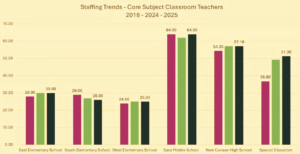By Peter Barhydt

Dr. Brian Luizzi, the Superintendent of New Canaan Public Schools, appeared before the Board of Education this week to give an update on the proposed school budget for the 2024/2025 school year. He began by addressing the community’s concerns and questions regarding the Kids In Crisis position at Saxe Middle School. The presentation aimed to clarify the funding intricacies and decisions surrounding the counselor position and shed light on the district’s commitment to providing essential support for students.
A social services organization, Kids In Crisis is based in Greenwich, Connecticut and provides emergency shelter, crisis counseling, and community education programs for children of all ages and families facing crisis.
The history of the Kids in Crisis position within the school system dates to 2009, initially established at the high school. Dr. Luizzi explained that in July 2021, discussions with Dr. Pierce of Health and Human Services led to the decision to establish a Kids in Crisis counselor at Saxe Middle School. The initiative was to be funded through COVID grant money, totaling approximately one million dollars allocated for counseling support.
Despite the plan, the position at Saxe Middle School remained unfilled throughout the 2021-22 academic year. In the summer of 2022, Kids In Crisis successfully hired a counselor, and the district used the COVID grant funds to cover the $96,000 cost for the 2022-23 academic year.
However, funding confusion arose as the town did not budget for the Kids In Crisis position for the current academic year. Dr. Luizzi explained that in September 2023, an agreement was reached with the town to continue paying for the position until a second counselor was found for the high school. During this period, the town contributed $32,000 toward Kids In Crisis.
The confusion persisted until November when a counselor was hired for the high school. A subsequent agreement was made between the district and the town to use COVID grant funds to cover the $64,000 difference between the initial $96,000 cost and the town’s $32,000 contribution. As a result, the district will have two Kids In Crisis counselors for the remainder of the school year—one at Saxe and one at the high school.
Dr. Luizzi emphasized that the decision-making process involved careful consideration of the best model to support students’ needs at Saxe. The district explored both Kids In Crisis and an internal position, ultimately choosing the latter for its potential to provide stability, build long-term relationships with students, and integrate seamlessly into the middle school community.
The Superintendent announced that, considering the experience gained from the pilot program, the district would propose adding a permanent internal counseling position to the budget at the upcoming Board of Finance meeting. This move, estimated to cost $68,000, is considered a net win compared to the $96,000 spent on Kids in Crisis previously.
Public Schools Staffing Trends: A Detailed Analysis
Dr. Luizzi went on to discuss the district’s staffing trends over the past seven years were scrutinized. The focus was on understanding the shifts in personnel and the corresponding impact on the budget. Dr. Luizzi delved into the numbers, providing a comprehensive breakdown, and emphasizing the strategic decisions made to enhance educational services in the face of evolving challenges.
The presentation opened with a contextual overview, emphasizing the significance of looking at trends rather than a detailed analysis. Dr. Luizzi set the baseline in 2018, pre-pandemic, to track the district’s progress over seven years. He immediately debunked the assumption that increasing staff correlates directly with rising costs, highlighting instances, such as the in-house transportation system, where bringing in staff resulted in cost savings.
A key takeaway was the district’s consistent fiscal responsibility. Dr. Luizzi stressed that despite the addition of 43 staff members (28 certified, 16 non-certified) since 2018, New Canaan Public Schools continued to spend less per student than 51 other towns. He said, “It’s important to note that our overall per pupil expenditure and the way that we have compared against others across the state, we’ve continued to pay less per pupil than other towns around us.”
The core of the presentation focused on specific departments and their staffing evolution. Classroom teachers and special education teachers were examined, with a spotlight on changes in response to shifting enrollment distribution across elementary and middle schools. Dr. Luizzi also addressed changes in administrative positions, academic support, and student support services, sharing his approach to managing resources.
One significant highlight was the emphasis on directly impacting student experience. Dr. Luizzi underlined that most changes occurred in positions directly interacting with students, such as classroom teachers and special area teachers. He also elaborated on the creation of new programs like the literacy academy, downtown campus, and launch program, showcasing the district’s wanting to provide innovative and tailored education.
Dr. Luizzi detailed adjustments in non-certified staff, revealing a deliberate effort to reallocate resources. By reducing teaching assistants in certain areas, funds were redirected to hire additional special education teachers, reinforcing the district’s commitment to enhancing the quality of education provided.
Dr. Luizzi said, “We do also though, more importantly than the budget, think that the quality of the services our students receive by the people who work for the New Canaan public schools are light years ahead of the quality of services they receive anywhere else.”
Addressing concerns about frivolous spending, Dr. Luizzi clarified that every staffing decision had been carefully considered. The reclassification of positions, elimination of some roles, and creation of new ones reflected a dynamic and proactive management approach to align resources with the evolving needs of the student population.
The presentation concluded with Dr. Luizzi presenting potential areas for budget reduction, including turnover savings, insurance adjustments, and delaying the installation of the public address system. He emphasized the district’s commitment to collaborating with the Board of Finance and exploring additional avenues for cost savings.
Dr. Luizzi acknowledged the complexity of the funding discussions, especially with grants that sunset after a certain period. He assured the community that the district’s priority is to best serve the students’ needs, and the decision to shift towards an in-house position reflects a strategic choice based on experience and student requirements.
In the coming weeks, New Canaan Public Schools will continue the budget approval process, meeting with the town council and refining their presentation based on ongoing discussions and feedback from the community.


